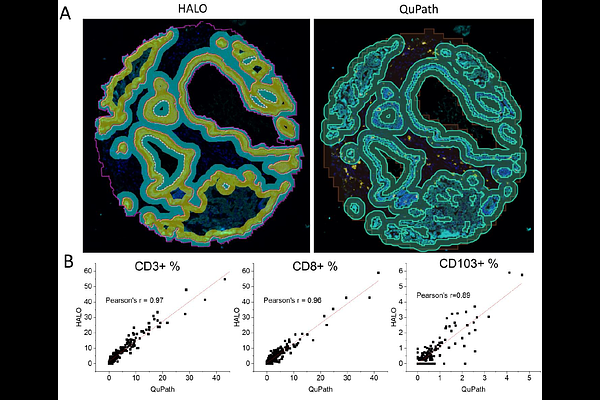Comparison of QuPath and HALO platforms for analysis of the tumor microenvironment in prostate cancer

Comparison of QuPath and HALO platforms for analysis of the tumor microenvironment in prostate cancer
zhang, w.; Zhou, Q.; Nguyen, J. V.; Egal, E.; Yang, Q.; Freeman, M. R.; Hu-Lieskovan, S.; Suneja, G.; Coghill, A.; Knudsen, B. S.
AbstractQuPath, an open-source digital pathology platform, has gained widespread use for image analysis in biomedical research since its release in 2016. However, its reproducibility and reliability compared to commercial software, such as HALO, requires further validation, particularly for multiplex immunofluorescence (mIF) analysis. In this study, we performed a direct comparison of QuPath and HALO using a mIF-stained prostate cancer tissue microarray (TMA) inclusive of 192 unique cores. We evaluated performance across three key analytical modules: immune cell phenotyping, tumor infiltration with immune cells, and nearest neighbor analysis. Furthermore, we integrated QuPath with CytoMap, an open-source spatial analysis tool, to perform unsupervised clustering of immune cell infiltration-a feature not available in HALO. Our results demonstrated high concordance between two platforms, with correlation coefficients exceeding 0.89 for immune cell density, distance and pattern of cell organization in tumor microenvironment (TME). A neighborhood analysis using CytoMap was further performed and provided a more detailed spatial analysis of immune cell distribution across different prostate cancer grades. A significant increase of CD103+ T cell infiltration into TME was observed in prostate cancer, which might be associated with the expression level of its ligand (E-cadherin) in the tumor region. In conclusion, our findings validate QuPath as a robust and reproducible alternative to commercial platforms for fluorescence-based digital pathology. By demonstrating QuPath capability to perform high-quality quantitative analysis with additional flexibility for integration with external tools, our study underscores its potential for advancing tumor microenvironment research in translational oncology.